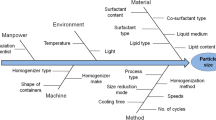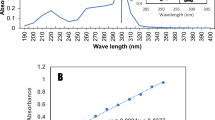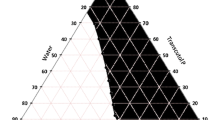Abstract
Even though quality by design is becoming an essential method for a development of pharmaceutical product, limited studies have been performed to develop topical drug delivery systems. The aim of this study was to apply a quality by design approach to achieve predictable critical quality attributes of a microemulsion-based hydrogel formulation (MBH) contained itraconazole (ITZ). The control and response factors were determined based on a risk assessment with primary knowledge. Benzyl alcohol (x1), Cremophor® EL (x2), and Transcutol® P (x3) were screened out and selected as oil, surfactant, and co-surfactant, respectively. A D-optimal mixture design was used for optimizing the formulation with desirable characteristics. To obtain an optimal formulation, globule size was minimized, while viscosity and pH were in the range of 500–700 cps × 103 and pH 5–7, respectively. The optimal formulation was characterized by globule size, pH, rheological properties, in vitro permeability, and drug release simulation with a mathematical model. The optimal formulation was stable when stored at 40 °C/75% relative humidity and at ambient temperature for 6 months. Therefore, this study suggests that the optimized MBH formulation may present a better alternative over conventional ITZ delivery systems against superficial fungal infections.






Similar content being viewed by others
References
Alam S, Iqbal Z, Ali A, Khar R, Ahmad F, Akhter S, Talegaonkar S (2009) Microemulsion as a potential transdermal carrier for poorly water soluble antifungal drug itraconazole. J Dispers Sci Technol 31:84–94
Basalious EB, Shawky N, Badr-Eldin SM (2010) SNEDDS containing bioenhancers for improvement of dissolution and oral absorption of lacidipine. I: development and optimization. Int J Pharm 391:203–211
Berner B, Wilson DR, Guy RH, Mazzenga GC, Clarke FH, Maibach HI (1988) The relationship of pK a and acute skin irritation in man. Pharm Res 5:660–663
Berner B, Wilson DR, Steffens RJ, Mazzenga GC, Hinz R, Guy RH, Maibach HI (1990) The relationship between pKa and skin irritation for a series of basic penetrants in man. Toxicol Sci 15:760–766
Boddé HE, Joosten JG (1985) A mathematical model for drug release from a two-phase system to a perfect sink. Int J Pharm 26:57–76
Chamkha AJ, Rashad M, Subba Reddy Gorla R (2014) Non-similar solutions for mixed convection along a wedge embedded in a porous medium saturated by a non-Newtonian nanofluid: natural convection dominated regime. Int J Numer Methods Heat Fluid Flow 24:1471–1486
Charoo NA, Ali AA (2013) Quality risk management in pharmaceutical development. Drug Dev Ind Pharm 39:947–960
Choi DH, Shin S, Viet Truong NK, Jeong SH (2012a) A new experimental design method to optimize formulations focusing on a lubricant for hydrophilic matrix tablets. Drug Dev Ind Pharm 38:1117–1127
Choi YK, Poudel BK, Marasini N, Yang KY, Kim JW, Kim JO, Choi H-G, Yong CS (2012b) Enhanced solubility and oral bioavailability of itraconazole by combining membrane emulsification and spray drying technique. Int J Pharm 434:264–271
Chudasama A, Patel V, Nivsarkar M, Vasu K, Shishoo C (2011) Investigation of microemulsion system for transdermal delivery of itraconazole. J Adv Pharm Technol Res 2:30–38
De Beule K, Van Gestel J (2001) Pharmacology of itraconazole. Drugs 61:27–37
Fang JY, Tsai MJ, Huang YB, Wu PC, Tsai YH (1997) Percutaneous absorption and skin erythema: quantification of capsaicin and its synthetic derivatives from gels incorporated with benzalkonium chloride by using non-invasive bioengineering methods. Drug Dev Res 40:56–67
Fouad SA, Basalious EB, El-Nabarawi MA, Tayel SA (2013) Microemulsion and poloxamer microemulsion-based gel for sustained transdermal delivery of diclofenac epolamine using in-skin drug depot: in vitro/in vivo evaluation. Int J Pharm 453:569–578
Friedman D, Benita S (1987) A mathematical morel for drug release from 0/W emulsions: application to controlled release morphine emulsions. Drug Dev Ind Pharm 13:2067–2085
Gelderblom H, Verweij J, Nooter K, Sparreboom A (2001) Cremophor EL: the drawbacks and advantages of vehicle selection for drug formulation. Eur J Cancer 37:1590–1598
Grassi M, Coceani N, Magarotto L (2000) Mathematical modeling of drug release from microemulsions: theory in comparison with experiments. J Colloid Interface Sci 228:141–150
Gupta S, Jhawat V (2017) Quality by design (QbD) approach of pharmacogenomics in drug designing and formulation development for optimization of drug delivery systems. J Control Release 245:15–26
Guy RH, Hadgraft J (1992) Rate control in transdermal drug delivery? Int J Pharm 82:R1–R6
Guy RH, Hadgraft J, Kellaway IW, Taylor M (1982) Calculations of drug release rates from particles. Int J Pharm 11:199–207
Hashiguchi T, Kodama A, Ryu A, Otagiri M (1998) Retention capacity of topical imidazole antifungal agents in the skin. Int J Pharm 161:195–204
Huang YB, Tsai YH, Yang WC, Chang JS, Wu PC, Takayama K (2004) Once-daily propranolol extended-release tablet dosage form: formulation design and in vitro/in vivo investigation. Eur J Pharm Biopharm 58:607–614
Huang YB, Tsai YH, Lee SH, Chang JS, Wu PC (2005) Optimization of pH-independent release of nicardipine hydrochloride extended-release matrix tablets using response surface methodology. Int J Pharm 289:87–95
Hulbert MH, Feely LC, Inman EL, Johnson AD, Kearney AS, Michaels J, Mitchell M, Zour E (2008) Risk management in the pharmaceutical product development process. J Pharm Innov 3:227–248
Idrees M, Rahman N, Ahmad S, Ali M, Ahmad I (2011) Enhance transdermal delivery of flurbiprofen via microemulsions: effects of different types of surfactants and cosurfactants. DARU 19:433–439
Kincl M, Turk S, Vrečer F (2005) Application of experimental design methodology in development and optimization of drug release method. Int J Pharm 291:39–49
Kumar N, Shishu (2015) D-optimal experimental approach for designing topical microemulsion of itraconazole: characterization and evaluation of antifungal efficacy against a standardized Tinea pedis infection model in Wistar rats. Eur J Pharm Sci 67:97–112
Lambers H, Piessens S, Bloem A, Pronk H, Finkel P (2006) Natural skin surface pH is on average below 5, which is beneficial for its resident flora. Int J Cosmet Sci 28:359–370
Lapasin R, Grassi M, Coceani N (2001) Effects of polymer addition on the rheology of o/w microemulsions. Rheol Acta 40:185–192
Lawrence MJ, Rees GD (2000) Microemulsion-based media as novel drug delivery systems. Adv Drug Deliv Rev 45:89–121
Le Dévédec F, Strandman S, Hildgen P, Leclair G, Zhu JX (2013) Pegylated bile acids for use in drug delivery systems: enhanced solubility and bioavailability of itraconazole. Mol Pharm 10:3057–3066
Lestner JM, Roberts SA, Moore CB, Howard SJ, Denning DW, Hope WW (2009) Toxicodynamics of itraconazole: implications for therapeutic drug monitoring. Clin Infect Dis 49:928–930
Lohitnavy M, Lohitnavy O, Thangkeattiyanon O, Srichai W (2005) Reduced oral itraconazole bioavailability by antacid suspension. J Clin Pharm Ther 30:201–206
Murphy M, Carmichael AJ (2000) Transdermal drug delivery systems and skin sensitivity reactions. Am J Clin Dermatol 1:361–368
Peltola S, Saarinen-Savolainen P, Kiesvaara J, Suhonen T, Urtti A (2003) Microemulsions for topical delivery of estradiol. Int J Pharm 254:99–107
Pena LE, Lee BL, Stearns JF (1994) Structural rheology of a model ointment. Pharm Res 11:875–881
Pereira-Lachataignerais J, Pons R, Panizza P, Courbin L, Rouch J, Lopez O (2006) Study and formation of vesicle systems with low polydispersity index by ultrasound method. Chem Phys Lipids 140:88–97
Rambali B, Verreck G, Baert L, Massart D (2003) Itraconazole formulation studies of the melt-extrusion process with mixture design. Drug Dev Ind Pharm 29:641–652
Rhee YS, Park CW, Nam TY, Shin YS, Chi SC, Park ES (2007) Formulation of parenteral microemulsion containing itraconazole. Arch Pharmacal Res 30:114–123
Saari TI, Grönlund J, Hagelberg NM, Neuvonen M, Laine K, Neuvonen PJ, Olkkola KT (2010) Effects of itraconazole on the pharmacokinetics and pharmacodynamics of intravenously and orally administered oxycodone. Eur J Clin Pharmacol 66:387–397
Shah RR, Magdum CS, Wadkar KA, Naikwade NS (2009) Fluconazole topical microemulsion: preparation and evaluation. Res J Pharm Technol 2:353–357
Sirotti C, Coceani N, Colombo I, Lapasin R, Grassi M (2002) Modeling of drug release from microemulsions: a peculiar case. J Membr Sci 204:401–412
Tang J, Wei H, Liu H, Ji H, Dong D, Zhu D, Wu L (2010) Pharmacokinetics and biodistribution of itraconazole in rats and mice following intravenous administration in a novel liposome formulation. Drug Deliv 17:223–230
Tenjarla S (1999) Microemulsions: an overview and pharmaceutical applications. Crit Rev Ther Drug Carr Syst 16:62
Trey SM, Wicks DA, Mididoddi PK, Repka MA (2007) Delivery of itraconazole from extruded HPC films. Drug Dev Ind Pharm 33:727–735
Valenta C, Schultz K (2004) Influence of carrageenan on the rheology and skin permeation of microemulsion formulations. J Control Release 95:257–265
Walsh TJ, Anaissie EJ, Denning DW, Herbrecht R, Kontoyiannis DP, Marr KA, Morrison VA, Segal BH, Steinbach WJ, Stevens DA (2008) Treatment of aspergillosis: clinical practice guidelines of the Infectious Diseases Society of America. Clin Intect Dis 46:327–360
Walters KA, Walker M, Olejnik O (1988) Non-ionic surfactant effects on hairless mouse skin permeability characteristics. J Pharm Pharmacol 40:525–529
Wang X, Xue M, Gu J, Fang X, Sha X (2012) Transdermal microemulsion drug delivery system for impairing male reproductive toxicity and enhancing efficacy of Tripterygium Wilfordii Hook f. Fitoterapia 83:690–698
Washington C (1990) Drug release from microdisperse systems: a critical review. Int J Pharm 58:1–12
Washington C, Evans K (1995) Release rate measurements of model hydrophobic solutes from submicron triglyceride emulsions. J Control Release 33:383–390
Xi J, Chang Q, Chan CK, Meng ZY, Wang GN, Sun JB, Wang YT, Tong HH, Zheng Y (2009) Formulation development and bioavailability evaluation of a self-nanoemulsified drug delivery system of oleanolic acid. AAPS PharmSciTech 10:172–182
Yu LX (2008) Pharmaceutical quality by design: product and process development, understanding, and control. Pharm Res 25:781–791
Zhu W, Yu A, Wang W, Dong R, Wu J, Zhai G (2008) Formulation design of microemulsion for dermal delivery of penciclovir. Int J Pharm 360:184–190
Zhu W, Guo C, Yu A, Gao Y, Cao F, Zhai G (2009) Microemulsion-based hydrogel formulation of penciclovir for topical delivery. Int J Pharm 378:152–158
Acknowledgements
The authors report no conflicts of interest. This work was supported by the Technology Innovation Program (Project No. SA112810) funded by the Small & Medium Business Administration (SMBA), Korea and the Basic Science Research Program through the National Research Foundation of Korea (NRF) funded by the Ministry of Education (2016R1D1A1B03931513).
Author information
Authors and Affiliations
Corresponding author
Additional information
Du Hyung Choi and Yun-Sik Kim have contributed equally to this work.
Rights and permissions
About this article
Cite this article
Choi, D.H., Kim, YS., Kim, DD. et al. QbD based development and evaluation of topical microemulsion-based hydrogel against superficial fungal infections. J. Pharm. Investig. 49, 87–103 (2019). https://doi.org/10.1007/s40005-018-0386-4
Received:
Accepted:
Published:
Issue Date:
DOI: https://doi.org/10.1007/s40005-018-0386-4




